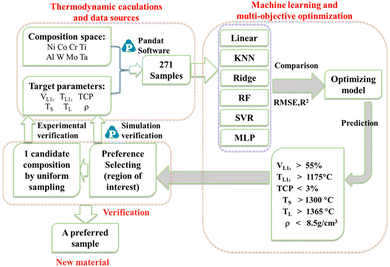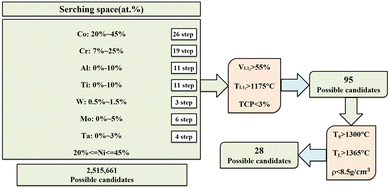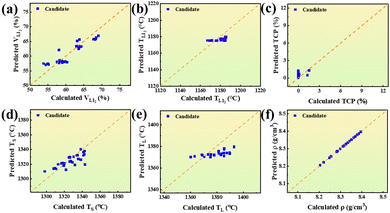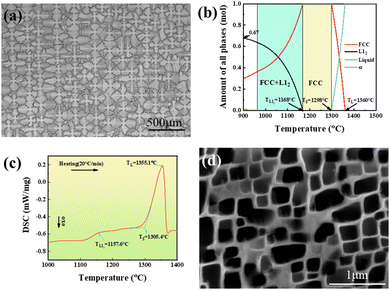 Open Access Article
Open Access ArticleAccelerated design of L12-strengthened single crystal high entropy alloys based on machine learning and multi-objective optimization
Wenchao
Yang
 *,
Shunsheng
Lin
,
Qiang
Wang
,
Chen
Liu
,
Jiarun
Qin
and
Jun
Zhang
*
*,
Shunsheng
Lin
,
Qiang
Wang
,
Chen
Liu
,
Jiarun
Qin
and
Jun
Zhang
*
State Key Laboratory of Solidification Processing, Northwestern Polytechnical University, Xi’an 710072, China. E-mail: wenchaoyang@nwpu.edu.cn; zhjscott@nwpu.edu.cn; Fax: +86-29-88492228; Tel: +86-29-88492228
First published on 11th June 2024
Abstract
A comprehensive strategy of machine learning and multi-objective optimization based on thermodynamic simulation data was proposed to accelerate the composition design of L12-strengthened single crystal high entropy alloys (SX-HEAs). This approach simultaneously optimized various alloy microscopic parameters, such as volume fraction and solvus temperature of L12 phase, TCP phase content, liquidus–solidus temperatures, and density, using a machine learning model. From a pool of 2![[thin space (1/6-em)]](https://www.rsc.org/images/entities/char_2009.gif) 515
515![[thin space (1/6-em)]](https://www.rsc.org/images/entities/char_2009.gif) 661 candidates, a composition of Ni41.5Co31Cr8Ti4Al10W0.5Mo2Ta3 (at%) was selected and then the related microscopic parameters were verified experimentally with a high accuracy. Furthermore, the designed alloy reached a yield strength of 873 MPa at 800 °C and 503 MPa at 1000 °C, as well as a creep life of 111.65 h at 1038 °C/158.6 MPa and 62.67 h at 1038 °C/172 MPa. This material design strategy based on machine learning and multi-objective optimization extends the L12-strengthened SX-HEAs design method to optimize simultaneously multiple objectives, rather than one by one.
661 candidates, a composition of Ni41.5Co31Cr8Ti4Al10W0.5Mo2Ta3 (at%) was selected and then the related microscopic parameters were verified experimentally with a high accuracy. Furthermore, the designed alloy reached a yield strength of 873 MPa at 800 °C and 503 MPa at 1000 °C, as well as a creep life of 111.65 h at 1038 °C/158.6 MPa and 62.67 h at 1038 °C/172 MPa. This material design strategy based on machine learning and multi-objective optimization extends the L12-strengthened SX-HEAs design method to optimize simultaneously multiple objectives, rather than one by one.
1. Introduction
High entropy alloys (HEAs)1–4 were a new alloy system based on configuration entropy principal alloy, which was considered one of the most promising alloys. This design concept broke the traditional alloy design concept of traditional metallic materials with single principal elements, showing the unique physical and mechanical properties.5–7 Among them, the coherent strengthening between the L12-type nanoparticles and FCC matrix showed the most promising strengthening effect to maintain the excellent mechanical properties over a wide temperature range.8–10However, the composition of multiple elements (Ti, Al, W, Mo, etc.) was crucial in determining the volume fraction of the L12 phase. An excessive increase in certain elements (such as Mo and W) could result in the formation of TCP phases (such as σ, η, μ, Laves, etc.) in HEAs.3,11–13 Additionally, it was worth noting that many L12-type nanoparticles could only maintain a thermal stability at relatively low temperatures (below 850 °C), which limited their potential for practical applications. This had been observed in the Al0.5CrCuNiCoFe HEAs system, where the L12 phase solvus temperature ranged from 800 °C to 850 °C.14 Furthermore, the current research on L12-strengthened HEAs has mainly focused on the polycrystalline structure. However, the polycrystalline HEAs also exhibited intergranular embrittlement like most structural materials. The phenomenon was particularly evident at intermediate temperatures, where polycrystalline materials tended to experience severe intergranular embrittlement due to stress-assisted oxygen infiltration along grain boundaries, leading to premature failure. These issues greatly hindered the widespread use of HEAs, especially in harsh environments. Notably, the synthesis of single crystals offered a promising solution for eliminating the negative effects of grain boundaries and had the potential to significantly improve the alloy's temperature capacity and high-temperature service performance.15–18 Therefore, it was of great significance to design the composition of L12-strengthened single crystal high entropy alloys (SX-HEAs).
The design of high-performance HEAs for L12-strengthened SX-HEAs presented a significant challenge due to the diverse range of alloy elements, composition, and single-crystal processing technology. Traditional trial-and-error or intuitive methods were often ineffective in this context. Therefore, it was necessary to find a more efficient and accelerated manner to discover multi-component HEAs with satisfactory multi-performance. In the past few decades, machine learning (ML) had increasingly been used in materials science research because of its efficient computational and predictive capabilities.19–26 For example, Zheng et al.18 for the first time innovatively used an experimental nickel-based database for ML to design and prepare HEAs with expected L12 phase volume fraction (>55%) and tensile strength (>1 GPa) in Al–Co–Cr–Fe–Ni–Ti six-element system. Liu et al.26 aimed to find HEAs with high L12 phase volume fraction and high hardness by establishing prediction models for multilayer structures, including precise prediction models for microstructure parameters and hardness properties. It was important to note that in the cases mentioned above, the design of HEAs often prioritizes a single microstructure parameter and room temperature performance. In the case of L12-strengthened SX-HEAs, it was crucial to accurately predict and characterize their properties under various high-temperature conditions, as well as their physical properties that reflected their performances at elevated temperatures. However, when the performance of L12-enhanced SX-HEAs was in conflict, it was not possible to consider a single ML model at the same time. Instead, multiple ML models must be constructed in order to optimize the performance one by one. To optimize the overall performance of a material, it was inevitable to face multiple constraints and property conflicts. Notably, the multi-objective optimization approach could effectively address the non-linear and multi-dimensional aspects of the alloy design problem.27
In this work, based on the calculation data established by the thermodynamic Pandat software, an ML model was built for the relationship of L12-strengthened SX-HEAs between compositions and L12 phase volume fraction (VL12), L12 phase solvus temperature (TL12), TCP phase content after heat treatment (TCP), solidus temperature (TS), liquidus temperature (TL) and density (ρ). A multi-objective screening and optimization process was developed for SX-HEAs by means of alloy composition design guidelines and material structure reverse design concepts. The reasonableness of the SX-HEA composition design method and the alloy design criteria in this work was indirectly verified by testing the microcosmic parameters of the designed alloy. Concurrently, the reliability of the design criteria was verified through tensile and creep tests conducted at elevated temperatures. The method would broaden the idea for the composition design of L12-strengthened single crystal HEAs in the future.
2. Method
2.1 Calculation method
![[thin space (1/6-em)]](https://www.rsc.org/images/entities/char_2009.gif) 515
515![[thin space (1/6-em)]](https://www.rsc.org/images/entities/char_2009.gif) 661 alloy compositions to be predicted. However, using the thermodynamic software Pandat to calculate all of these components would be time-consuming. Therefore, in this work, based on the reported distribution characteristics of alloy components,2,3,6–8,14 271 components were randomly selected, including the phase content of the equilibrium state at 900 °C, and finally established surrogate models through ML.
661 alloy compositions to be predicted. However, using the thermodynamic software Pandat to calculate all of these components would be time-consuming. Therefore, in this work, based on the reported distribution characteristics of alloy components,2,3,6–8,14 271 components were randomly selected, including the phase content of the equilibrium state at 900 °C, and finally established surrogate models through ML.
 | (1) |
 | (2) |
 standed for the predicted value of the i-th sample, and
standed for the predicted value of the i-th sample, and  was the average of the observation value. In addition, m was the number of data samples. The smaller the RMSE, the model error would be smaller. The R2 within [0,1] was an evaluating indicator to represent for the proportion of response variation “explained” by the regressors.
was the average of the observation value. In addition, m was the number of data samples. The smaller the RMSE, the model error would be smaller. The R2 within [0,1] was an evaluating indicator to represent for the proportion of response variation “explained” by the regressors.
2.2 Experimental procedure
One candidate composition obtained by ML and multi-objective optimization was verified by experiments. Raw metals with a purity higher than 99.9% were applied. Alloy button ingots were prepared by vacuum arc melting. To ensure the uniformity of the alloy composition, the alloy was melted at least 6 times per 100 g and homogenized by the magnetic stirring of the vacuum electric arc furnace. Then the button ingots were directionally solidified into [001] single crystal rod by high-rate solidification (HRS) technology at a withdrawal rate of 100 μm s−1. The heat treatment regime of the alloy was 1220 °C/1 h + 1230 °C/2 h + 1240 °C/2 h + 1250 °C/4 h A.C. + 1050 °C/4 h A.C. The density of the alloy was determined by the Archimedean drainage method. The transformation temperatures were measured by differential scanning calorimetry (DSC)-STA449F3 within the high-purity Ar flow. The sample in 3 mm × 3 mm × 0.5 mm for DSC was tested within the temperature range of 600–1400 °C at a heating rate of 20 °C min−1. The linear interpolation method was employed to measure TL12, TS, and TL based on the DSC heating curves. The etched chemically with the solution of HNO3![[thin space (1/6-em)]](https://www.rsc.org/images/entities/char_2009.gif) :
:![[thin space (1/6-em)]](https://www.rsc.org/images/entities/char_2009.gif) HF
HF![[thin space (1/6-em)]](https://www.rsc.org/images/entities/char_2009.gif) :
:![[thin space (1/6-em)]](https://www.rsc.org/images/entities/char_2009.gif) C3H8O3 in volume ratio of 1
C3H8O3 in volume ratio of 1![[thin space (1/6-em)]](https://www.rsc.org/images/entities/char_2009.gif) :
:![[thin space (1/6-em)]](https://www.rsc.org/images/entities/char_2009.gif) 2
2![[thin space (1/6-em)]](https://www.rsc.org/images/entities/char_2009.gif) :
:![[thin space (1/6-em)]](https://www.rsc.org/images/entities/char_2009.gif) 3. The microstructures were characterized by TESCAN Clara GMH scanning electron microscope (SEM) and Leica DM3000 optical microscopy (OM). Rod specimens with diameter of 3 mm and standard distance of 15 mm were used to evaluate their tensile properties. Uniaxial tensile tests were conducted at a nominal strain rate of 2.5 × 10−3 s−1 along the [001] direction in the temperature range from RT to 1000 °C, such as 800 °C, 900 °C, and 1000 °C. Rod specimens with a diameter of 5 mm and a standard distance of 25 mm were used to evaluate their tensile properties. A set of uniaxial constant loading tensile creep tests was accomplished at 1038 °C/158.6 MPa, and 1038 °C/172 MPa. All the creep tests were carried out in a TM105-A1 creep testing machine.
3. The microstructures were characterized by TESCAN Clara GMH scanning electron microscope (SEM) and Leica DM3000 optical microscopy (OM). Rod specimens with diameter of 3 mm and standard distance of 15 mm were used to evaluate their tensile properties. Uniaxial tensile tests were conducted at a nominal strain rate of 2.5 × 10−3 s−1 along the [001] direction in the temperature range from RT to 1000 °C, such as 800 °C, 900 °C, and 1000 °C. Rod specimens with a diameter of 5 mm and a standard distance of 25 mm were used to evaluate their tensile properties. A set of uniaxial constant loading tensile creep tests was accomplished at 1038 °C/158.6 MPa, and 1038 °C/172 MPa. All the creep tests were carried out in a TM105-A1 creep testing machine.
3. Results and discussion
3.1 Establishments of ML and multi-objective optimization
![[thin space (1/6-em)]](https://www.rsc.org/images/entities/char_2009.gif) 515
515![[thin space (1/6-em)]](https://www.rsc.org/images/entities/char_2009.gif) 661. It was worth noting that the content of each element was limited to 45 at% to ensure the predicted alloy components fall within the reasonable range for HEAs. Additionally, according to previous research by Liu et al.,26 the content of Ti and Al were the forming elements of the L12 phase, which should be restricted to 10 at% to prevent a phase transition from FCC to BCC in the alloy.24,30 The objective of this work was to enhance the mechanical properties of HEAs at high temperatures by adding appropriate refractory elements such as W, Mo and Ta. Therefore, a multi-objective optimization process was conducted for all alloy components within the predicted measurement space. Initially, the criteria of VL12 > 55%, TL12 > 1175 °C, and TCP < 3% were imposed, resulting in the identification of 95 potential alloy components. This step was crucial in the development of an alloy that could maintain a high-volume fraction of the L12 phase and exhibit the structural stability under high-temperature conditions. Subsequently, the criteria of TS > 1300 °C, TL > 1365 °C, and ρ < 8.5 g cm−3 were applied, leading to the selection of 28 alloy compositions. This step was essential in designing an alloy with excellent performance at high temperatures and ensured its practical application in engineering.
661. It was worth noting that the content of each element was limited to 45 at% to ensure the predicted alloy components fall within the reasonable range for HEAs. Additionally, according to previous research by Liu et al.,26 the content of Ti and Al were the forming elements of the L12 phase, which should be restricted to 10 at% to prevent a phase transition from FCC to BCC in the alloy.24,30 The objective of this work was to enhance the mechanical properties of HEAs at high temperatures by adding appropriate refractory elements such as W, Mo and Ta. Therefore, a multi-objective optimization process was conducted for all alloy components within the predicted measurement space. Initially, the criteria of VL12 > 55%, TL12 > 1175 °C, and TCP < 3% were imposed, resulting in the identification of 95 potential alloy components. This step was crucial in the development of an alloy that could maintain a high-volume fraction of the L12 phase and exhibit the structural stability under high-temperature conditions. Subsequently, the criteria of TS > 1300 °C, TL > 1365 °C, and ρ < 8.5 g cm−3 were applied, leading to the selection of 28 alloy compositions. This step was essential in designing an alloy with excellent performance at high temperatures and ensured its practical application in engineering.
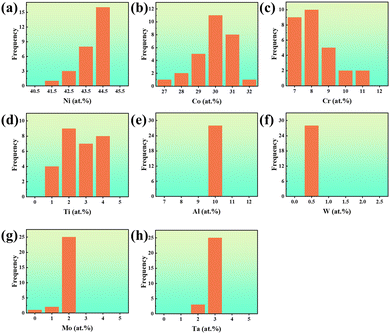 | ||
| Fig. 5 Frequency maps of the filtered 28 alloys composition: (a)–(h) were the frequency maps of Ni, Co, Cr, Ti, Al, W, Mo, and Ta, respectively. | ||
On the one hand, the distribution of Ni, Co, Cr, and Ti (Fig. 5a–d) in the alloy was uneven, with no clear advantage in the occurrence frequency of any one element. This work focused on the design of L12–(Ni3Al) type precipitated phase.6 The content of Ni in the final alloy was over 40 at%, and the content of Co was between 27 at% and 32 at%. The sum of the content of the two elements accounted for about 3/4, which should occupy the central position of the 6 faces of the Ni3Al structure. Similarly, the elements Cr and Ti should occupy 8 corner positions of the Ni3Al structure.6 The above results also verified the reliability of ML methods in alloy design and alloy screened.
On the other hand, the Al and W contents were fixed at 10 at% and 0.5 at%, respectively (Fig. 5e and f). The Al was the formed element of the L12–(Ni3Al) type precipitated phase, and the content of Al in the 28 candidate alloys in this example was 10 at%, indicating that increased the Al content would also increase the volume fraction of the L12 phase. The W element played a crucial role in improving the high-temperature performance of the alloy. In this work, the search range for W content was set at 0.5–1.5 at% (Fig. 3) to enhance the high-temperature performance of the final designed alloy. However, in this particular example, the W content in the final screened alloy composition was fixed at 0.5 at% due to the synergistic effects it had on the 6 output parameters. The increase of W content further would make it difficult to achieve the multi-objective optimization design objectives.
Finally, Mo and Ta had the highest frequencies when the content of Mo and Ta appeared at 2 at% and 3 at%, respectively (Fig. 5g and h). As a refractory element, Mo also played an important role in improving high-temperature performance. However, when its content was too high, the TCP phase might be precipitated on the matrix, thus significantly damaging the high-temperature durability of the alloy.32 According to machine learning, the comprehensive sensitivity of Mo to the range of 6 output parameters was highest at 2 at%, while no relevant component occurred at 3–5 at%. No related components were found in 3–5 at%, indicating that the further increase of Mo element promoted the precipitation of the TCP phase. Pandey et al.6 promoted the L12 phase solvus temperature of the HEAs to 1156 °C by addition of 2.8 at% Ta element. In this work, the alloy selection was carried out by ML, and the final occurrence frequency of Ta element was 3 at%, indicating that the addition of Ta not only increased the L12 phase solvus temperature in the alloy but also made the comprehensive sensitivity to meet the requirements of the range of 6 output parameters the highest.
In summary, the contents of Al, W, Mo, and Ta were fixed at 10 at%, 0.5 at%, 2 at%, and 3 at%, respectively, based on the results and discussion in this section. However, the contents of the other four elements have not yet been determined. Further analysis would be conducted in the next section to determine the final experimental composition.
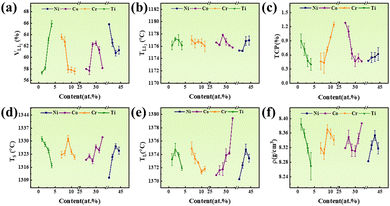 | ||
| Fig. 6 The influence of element content change on all targets: (a) VL12; (b) TL12; (c) TCP; (d) TS; (e) TL; (f) ρ. | ||
According to the rule of the influence of alloying element content on 6 output parameters, this work selected 28 alloy components to verify the alloy composition. The goal was to minimize the content of the Ni element, maximize the content of the Co element, minimize the content of the Cr element, and maximize the content of the Ti element. The aim was to ensure that the final selected alloy would have high values for VL12, TL12, TS, TL, and low values for TCP and ρ. After considered the practical situation of the 28 alloy compositions, the study determined the composition of the tested alloy to be Ni41.5Co31Cr8Ti4Al10W0.5Mo2Ta3 (at%).
3.2 Experimental verification
By comparing the results of the experiment, thermodynamic Pandat software, and ML, as shown in Table 1, it could be seen that the differences among the three results were within a reasonable range. It was similar to the results of Deng et al.32 Furthermore, the above results showed that machine learning using thermodynamic software was reasonable, and its prediction results could effectively guide the alloy design.
| Result | Experimental | Pandat | ML |
|---|---|---|---|
| V L12 (%) | 68 | 67 | 66 |
| T L12 (°C) | 1157.6 | 1168 | 1175 |
| TCP (%) | 0 | 0.54 | 0.46 |
| T S (°C) | 1305.4 | 1298 | 1310 |
| T L (°C) | 1355.1 | 1360 | 1370 |
| ρ (g cm−3) | 8.45 | 8.41 | 8.43 |
In addition, the properties of the alloys designed in this work were compared with those of other alloys. A radar diagram comparing the various properties of the design alloy with HEA CoNi and CMSX-2 was shown in Fig. 8.6,33,34 The SX-HEAs developed in this work outperforms HEA CoNi (Co37.6Ni35.4Al9.9Mo4.9 Cr5.9Ta2.8Ti3.5) in all the properties displayed in the figure, while also reducing cost and density. Compared to the first-generation nickel-based single-crystal superalloy CMSX-2, HEA showed better performance in all areas except TL12 and price. Overall, significant improvements had been achieved in terms of performance when compared to the CMSX-2 alloy. Notably, SX-HEA had a lighter density than CMSX-2 (SX-HEA: 8.45 g cm−3, CMSX-2: 8.56 g cm−3). In the aviation industry, reducing weight had always been a sought-after goal.
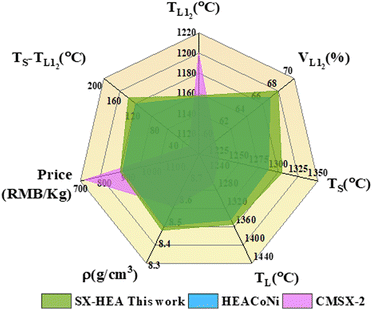 | ||
| Fig. 8 Radar diagram of SX-HEA, HEA CoNi, and CMSX-2 on multiple properties.6,33,34 | ||
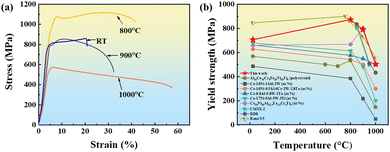 | ||
| Fig. 9 Tensile curves and performances comparison of SX-HEA: (a) stress–strain curves of SX-HEA at RT, 800 °C, 900 °C, 1000 °C; (b) yield strength of SX-HEA at different temperatures, compared with that of polycrystalline HEAs and other single crystal nickel-based superalloys, cobalt-based superalloys and HEAs.17,38–44 | ||
| Temperature (°C) | YS (MPa) | UTS (MPa) | φ (%) |
|---|---|---|---|
| RT | 707 | 860 | 17 |
| 800 | 873 | 1117 | 35 |
| 900 | 790 | 854 | 28 |
| 1000 | 503 | 571 | 54 |
In addition, the creep performances of SX-HEA were also tested. The creep properties of SX-HEA at 1038 °C/158.6 MPa and 1038 °C/172 MPa were shown in Fig. 10a. Under these two conditions, the creep life was 111.65 h and 62.67 h, and the fracture elongation was 30.12% and 27.26%, respectively. To evaluate the creep properties of SX-HEA, nickel-based single-crystal superalloys, novel cobalt-based single-crystal superalloys, and published L12-strengthened SX-HEA were selected for comparison. Fig. 10b showed L–M curves of different alloys (L–M coefficient (P = (T + 273)(20 + lgt)/1000), where T was the experimental temperature and t was the creep rupture life). In this paper, the L–M coefficients of SX-HEA at 1038 °C/158.6 MPa and 1038 °C/172 MPa were 28.91 and 28.51, respectively. Compared with the SX-HEA,46 the first-generation nickel-based single crystal superalloy PWA-1483,47 and the new cobalt-based single crystal superalloys,48,49 the L–M coefficient points of SX-HEA were on the right or above, indicating that the designed alloy had the better creep properties than the above alloys. At the same time, the L–M coefficient points of the designed alloy were close to that of the first generation single crystal CMSX-2, and slightly to the left of the second generation single crystal Rene N5 L–M coefficient point,50,51 indicating that the creep performance of SX-HEA was the same as that of the first generation single crystal CMSX-2 and slightly lower than Rene N5. Considering that the density of CMSX-2 was 8.56 g cm−3 and the density of the alloy designed in this work was 8.45 g cm−3, the alloy designed in this work still had the characteristics of low density under the condition of basically equivalent performance, and it had a certain application potential.
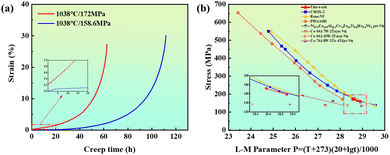 | ||
| Fig. 10 Creep fracture curves and performances comparison of SX-HEA: (a) Overall strain–creep curves of SX-HEA at 1038 °C/158.6 MPa and 1038 °C/172 MPa; (b) Comparison of L–M coefficients between SX-HEA and some alloys.45–50 | ||
4. Conclusion
In this work, a design strategy based on ML and multi-objective optimization was proposed for the discovery of a new L12-strengthened SX-HEA. The conclusions were drawn as follows.(1) By using the RF model and combining the design criteria of VL12, TL12, TCP, TS, TL, and ρ, one alloy was selected from 2![[thin space (1/6-em)]](https://www.rsc.org/images/entities/char_2009.gif) 515
515![[thin space (1/6-em)]](https://www.rsc.org/images/entities/char_2009.gif) 661 alloys. The experimental results showed that the surrogate model based on error evaluation had high accuracy. The VL12, TL12, TCP, TS, TL and ρ in Ni41.5Co31Cr8Ti4Al10W0.5Mo2Ta3 (at%) were 68%, 1157.6 °C, 0%, 1305.4 °C, 1355.1 °C and 8.45 g cm−3, respectively.
661 alloys. The experimental results showed that the surrogate model based on error evaluation had high accuracy. The VL12, TL12, TCP, TS, TL and ρ in Ni41.5Co31Cr8Ti4Al10W0.5Mo2Ta3 (at%) were 68%, 1157.6 °C, 0%, 1305.4 °C, 1355.1 °C and 8.45 g cm−3, respectively.
(2) The yield strength of SX-HEA was 873 MPa and 503 MPa at 800 °C and 1000 °C, respectively. The creep life at 1038 °C/158.6 MPa and 1038 °C/172 MPa were 111.65 h and 62.67 h, respectively. The mechanical properties were of SX-HEAs better than some single-crystal alloys.
(3) This material design strategy based on ML and multi-objective optimization extended the L12-strengthened SX-HEAs design method to optimize multiple targets simultaneously, rather than one by one. At the same time, the design concept and theoretical results of auxiliary alloys would provide important guidance for the further study of new L12-strengthened SX-HEAs.
Data availability statements
The data that support the findings of this study are available from the corresponding author upon request.Conflicts of interest
The authors declare that they have no known competing financial interests or personal relationships that could have appeared to influence the work reported in this paper.Acknowledgements
This work was funded by the National Natural Science Foundation of China (52322410, 52071263, 52031012); Self-innovation Special Fund Project of Aero Engine Corporation of China (ZZCX-2022-040); The Key Research and Development Program of Shaanxi Province (2023-YBGY-432); Research Fund of the State Key Laboratory of Solidification Processing (NPU), China (2021-QZ-03) and Science Center for Gas Turbine Project (P2021-A-IV-001-001).References
- J. W. Yeh, S. K. Chen, S. J. Lin, J. Y. Gan, T. S. Chin, T. T. Shun, C. H. Tsau and S. Y. Chang, Nanostructured high-entropy alloys with multiple principal elements: novel alloy design concepts and outcomes, Adv. Eng. Mater., 2004, 6, 299–303 CrossRef CAS.
- Y. F. Ye, Q. Wang, C. T. Liu and Y. Yang, High-entropy alloy: challenges and prospects, Mater. Today, 2016, 19, 349–362 CrossRef CAS.
- T. Yang, Y. Zhao, W. Liu, J. Kai and C. Liu, L12-strengthened high-entropy alloys for advanced structural applications, J. Mater. Res., 2018, 33, 2983–2997 CrossRef CAS.
- Z. P. Lu, H. Wang, M. W. Chen, I. Baker, J. W. Yeh, C. T. Liu and T. G. Nieh, An assessment on the future development of high-entropy alloys: Summary from a recent workshop, Intermetallics, 2015, 66, 67–76 CrossRef CAS.
- T. Yang, Y. L. Zhao, B. X. Cao, J. J. Kai and C. T. Liu, Towards superior mechanical properties of hetero-structured high-entropy alloys via engineering multicomponent intermetallic nanoparticles, Scr. Mater., 2020, 183, 39–44 CrossRef CAS.
- P. Pandey, S. Kashyap, D. Palanisamy, A. Sharma and K. Chattopadhyay, On the high temperature coarsening kinetics of γ′ precipitates in a high strength Co37.6Ni35.4Al9.9Mo4.9Cr5.9Ta2.8Ti3.5 fcc-based high entropy alloy, Acta Mater., 2019, 177, 82–95 CrossRef CAS.
- Y. L. Zhao, Y. R. Li, G. M. Yeli, J. H. Luan, S. F. Liu, W. T. Lin, D. Chen, X. J. Liu, J. J. Kai, C. T. Liu and T. Yang, Anomalous precipitate-size-dependent ductility in multicomponent high-entropy alloys with dense nanoscale precipitates, Acta Mater., 2022, 223, 117480 CrossRef CAS.
- J. Y. He, H. Wang, Y. Wu, X. J. Liu, H. H. Mao, T. G. Nieh and Z. P. Lu, Precipitation behavior and its effects on tensile properties of FeCoNiCr high-entropy alloys, Intermetallics, 2016, 79, 41–52 CrossRef CAS.
- J. Y. He, H. Wang, H. L. Huang, X. D. Xu, M. W. Chen, Y. Wu, X. J. Liu, T. G. Nieh, K. An and Z. P. Lu, A precipitation-hardened high-entropy alloy with outstanding tensile properties, Acta Mater., 2016, 102, 187–196 CrossRef CAS.
- Y. L. Zhao, T. Yang, Y. R. Li, L. Fan, B. Han, Z. B. Jiao, D. Chen, C. T. Liu and J. J. Kai, Superior high-temperature properties and deformation-induced planar faults in a novel L12-strengthened high-entropy alloy, Acta Mater., 2020, 188, 517–527 CrossRef CAS.
- J. X. Hou, B. X. Cao, B. Xiao, Z. B. Jiao and T. Yang, Compositionally complex coherent precipitation-strengthened high-entropy alloys: a critical review, Rare Met., 2022, 41, 2002–2015 CrossRef CAS.
- B. Cao, T. Yang, W. Liu and C. T. Liu, Precipitation-hardened high-entropy alloys for high-temperature applications: A critical review, MRS Bull., 2019, 44, 854–859 CrossRef.
- Y. L. Zhao, T. Yang, Y. Tong, J. Wang, J. H. Luan, Z. B. Jiao, D. Chen, Y. Yang, A. Hu, C. T. Liu and J. J. Kai, Heterogeneous precipitation behavior and stacking-fault-mediated deformation in a CoCrNi-based medium-entropy alloy, Acta Mater., 2017, 138, 72–82 CrossRef CAS.
- N. G. Jones, A. Frezza and H. J. Stone, Phase equilibria of an Al0.5CrFeCoNiCu high entropy alloy, Mater. Sci. Eng. A., 2014, 615, 214–221 CrossRef CAS.
- Z. Wan, L. Hu, Y. Sun, T. Wang and Z. Li, Microstructure evolution and dynamic softening mechanisms during high-temperature deformation of a precipitate hardening Ni-based superalloy, Vacuum, 2018, 155, 585–593 CrossRef CAS.
- E. I. Galindo-Nava and P. E. J. Rivera-Díaz-del-Castillo, Thermostatistical modelling of hot deformation in FCC metals, in J. Plast, 2013, 47, pp. 202–221 Search PubMed.
- W. C. Xiao, S. F. Liu, Y. L. Zhao, J. J. Kai, X. J. Liu and T. Yang, A novel single-crystal L12-strengthened Co-rich high-entropy alloy with excellent high-temperature strength and antioxidant property, J. Mater. Res. Technol., 2023, 23, 2343–2350 CrossRef CAS.
- S. G. Ma, S. F. Zhang, M. C. Gao, P. K. Liaw and Y. Zhang, A successful synthesis of the CoCrFeNiAl0.3 single-crystal, high-entropy alloy by Bridgman solidification, JOM, 2013, 65, 1751–1758 CrossRef CAS.
- T. Zheng, X. Hu, F. He, Q. Wu, B. Han, C. Da, J. Li, Z. Wang, J. Wang, J. Kai, Z. Xia and C. T. Liu, Tailoring nanoprecipitates for ultra-strong high-entropy alloys via machine learning and prestrain aging, J. Mater. Sci. Technol., 2021, 69, 156–167 CrossRef CAS.
- W. Huang, P. Martin and H. L. Zhuang, Machine-learning phase prediction of high-entropy alloys, Acta Mater., 2019, 169, 225–236 CrossRef CAS.
- C. Wen, Y. Zhang, C. Wang, D. Xue, Y. Bai, S. Antonov, L. Dai, T. Lookman and Y. Su, Machine learning assisted design of high entropy alloys with desired property, Acta Mater., 2019, 170, 109–117 CrossRef CAS.
- Y. J. Chang, C. Y. Jui, W. J. Lee and A. C. Yeh, Prediction of the composition and hardness of high-entropy alloys by machine learning, JOM, 2019, 71, 3433–3442 CrossRef CAS.
- Y. Zhang, C. Wen, C. Wang, S. Antonov, D. Xue, Y. Bai and Y. Su, Phase prediction in high entropy alloys with a rational selection of materials descriptors and machine learning models, Acta Mater., 2020, 185, 528–539 CrossRef CAS.
- X. Liu, J. Zhang and Z. Pei, Machine learning for high-entropy alloys: Progress, challenges and opportunities, Prog. Mater. Sci., 2023, 131, 101018 CrossRef.
- Q. Han, Z. Lu, S. Zhao, Y. Su and H. Cui, Data-driven based phase constitution prediction in high entropy alloys, Comp, Mater. Sci., 2022, 215, 111774 CAS.
- W. Liu, C. Wang, C. Liang, J. Chen, H. Tan, J. Yang, M. Liang, X. Li, C. Liu, M. Huang and X. Liu, Optimal design of γ′-strengthened high-entropy alloys via machine learning multilayer structural model, Mater. Sci. Eng., A, 2023, 871, 144852 CrossRef CAS.
- A. Gaspar-Cunha and J. A. Cova, Robustness in multi-objective optimization using evolutionary algorithms, Comput. Optim. Appl., 2008, 39, 75–96 CrossRef.
- J. Joseph, M. Annasamy, S. R. Kada, P. D. Hodgson, M. R. Barnett and D. M. Fabijanic, Optimising the Al and Ti compositional window for the design of γ′ (L12)-strengthened Al–Co–Cr–Fe–Ni–Ti high entropy alloys, Mater. Sci. Eng., A, 2022, 835, 142620 CrossRef CAS.
- P. Liu, H. Huang, S. Antonov, C. Wen, D. Xue, H. Chen, L. Li, Q. Feng, T. Omori and Y. Su, Machine learning assisted design of γ′-strengthened Co-base superalloys with multi-performance optimization, npj Comput. Mater., 2020, 6, 62 CrossRef CAS.
- T. Borkar, B. Gwalani, D. Choudhuri, C. V. Mikler, C. J. Yannetta, X. Chen, R. V. Ramanujan, M. J. Styles, M. A. Gibson and R. Banerjee, A combinatorial assessment of AlxCrCuFeNi2 (0 < x < 1.5) complex concentrated alloys: Microstructure, microhardness, and magnetic properties, Acta Mater., 2016, 116, 63–76 CrossRef CAS.
- Y. Deng, Y. Zhang, X. Gong, W. Hu, Y. Wang, Y. Liu and L. Lian, An intelligent design for Ni-based superalloy based on machine learning and multi-objective optimization, Mater. Des., 2022, 221, 110935 CrossRef CAS.
- B. X. Cao, T. Yang, L. Fan, J. H. Luan, Z. B. Jiao and C. T. Liu, Refractory alloying additions on the thermal stability and mechanical properties of high-entropy alloys, Mater. Sci. Eng., A, 2020, 797, 140020 CrossRef CAS.
- T. Grosdidier, A. Hazotte and A. Simon, Precipitation and dissolution processes in γ/γ′ single crystal nickel-based superalloys, Mater. Sci. Eng., A, 1998, 256, 183–196 CrossRef.
- M. Okazak, M. Sakaguchi and R. Kamma, Early growth of creep-fatigue small cracks in an advanced cast Ni-based superalloys, Trans. Indian Inst. Met., 2010, 63, 259–263 CrossRef.
- R. C. Reed, The superalloys: fundamentals and applications, Cambridge university press, 2008 Search PubMed.
- H. M. Daoud, A. M. Manzoni, N. Wanderka and U. Glatzel, High-temperature tensile strength of Al10Co25Cr8Fe15Ni36Ti6 compositionally complex alloy (high-entropy alloy), JOM, 2015, 67, 2271–2277 CrossRef CAS.
- T. K. Tsao, A. C. Ye, C. M. Ku and H. Murakami, On the superior high temperature hardness of precipitation strengthened high entropy Ni-based alloys, Adv. Eng. Mater., 2017, 19, 1600475 CrossRef.
- A. Korner, H. P. Karnthaler and C. Hitzenberger, Transmission electron microscopy study of cross-slip and of Kear-Wilsdorf locks in L12 ordered Ni3Fe, Philos. Mag. A, 1987, 56, 73–88 CrossRef CAS.
- N. Petrushin, K. Hvatzkiy, V. Gerasimov, T. Link, A. Epishin, G. Nolze and G. Gerstein, A Single-Crystal Co-Base Superalloy Strengthened by γ′ Precipitates: Structure and Mechanical Properties, Adv. Eng. Mater., 2015, 17, 755–760 CrossRef CAS.
- L. Shi, J. J. Yu, C. Y. Cui and X. F. Sun, Temperature dependence of deformation behavior in a Co-Al-W-base single crystal superalloy, Mater. Sci. Eng., A, 2015, 620, 36–43 CrossRef.
- L. Klein, Y. Shen, M. S. Killian and S. Virtanen, Effect of B and Cr on the high temperature oxidation behaviour of novel γ/γ′-strengthened Co-base superalloys, Corros. Sci., 2011, 53, 2713–2720 CrossRef CAS.
- L. Shi, J. J. Yu, C. Y. Cui and X. F. Sun, Effect of Ta additions on microstructure and mechanical properties of a single-crystal Co-Al-W-base alloy, Mater. Lett., 2015, 149, 58–61 CrossRef CAS.
- P. J. Cong, J. S. Hou, L. Z. Zhou, Z. M. Ren and J. T. Guo, Effects of disorientation on tensile properties of hot corrosion resistant single crystal superalloy DD483, Chin. J. Nonferrous Met., 2001, 21, 747–753 Search PubMed.
- F. R. N. Nabarro and F. De Villiers, Physics of creep and creep-resistant alloys, CRC press, 2018 Search PubMed.
- J. Corrigan, M. G. Launsbach and J. R. Mihalisin, Nickel base superalloy and single crystal castings, US Pat 8241560 B2, 2012 Search PubMed.
- T. K. Tsao, A. C. Yeh, C. M. Kuo, K. Kakehi, H. Murakami, J. W. Yeh and S. R. Jian, The high temperature tensile and creep behaviors of high entropy superalloy, Sci. Rep., 2017, 7, 12658 CrossRef PubMed.
- D. M. Shah and A. Cetel, Evaluation of PWA1483 for large single crystal IGT blade applications, Superalloys., 2000, 2000, 295–304 Search PubMed.
- F. Xue, H. J. Zhou and Q. Feng, Improved high-temperature microstructural stability and creep property of novel Co-base single-crystal alloys containing Ta and Ti, JOM, 2014, 66, 2486–2494 CrossRef CAS.
- S. Lu, S. Antonov, L. Li, C. Liu, X. Zhang, Y. Zheng, H. L. Fraser and Q. Feng, Atomic structure and elemental segregation behavior of creep defects in a Co-Al-W-based single crystal superalloys under high temperature and low stress, Acta Mater., 2020, 190, 16–28 CrossRef CAS.
- J. Gong, D. Snyder, T. Kozmel, C. Kern, J. E. Saal, I. Berglund, J. Sebastian and G. Olson, ICME design of a castable, creep-resistant, single-crystal turbine alloy, JOM, 2017, 69, 880–885 CrossRef.
- J. B. Wahl and K. Harris, New single crystal superalloys, CMSX®-8 and CMSX®-7. American Society of Mechanical Engineers, 2014, 45752, V006T22A002 Search PubMed.
| This journal is © The Royal Society of Chemistry 2024 |

